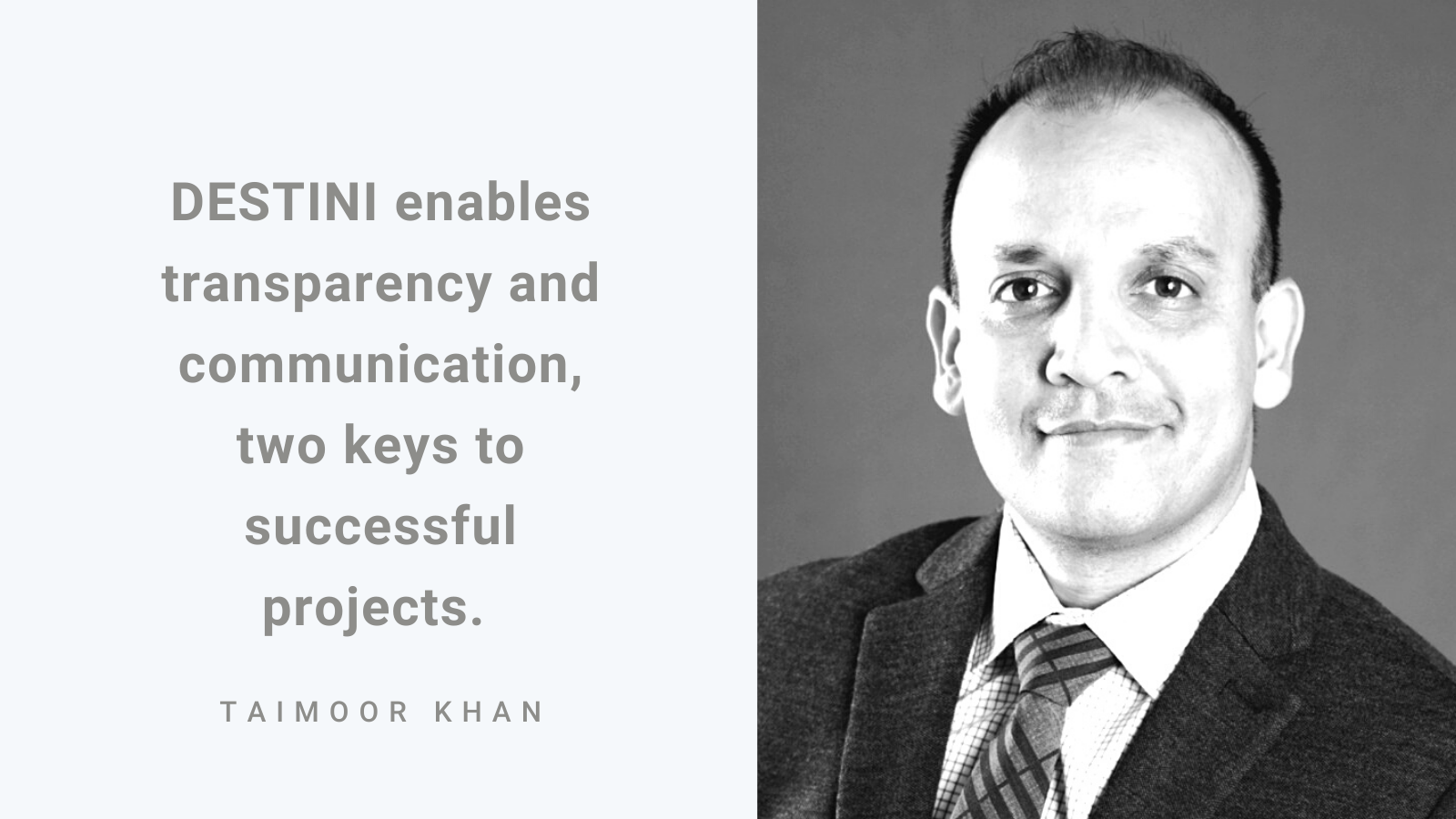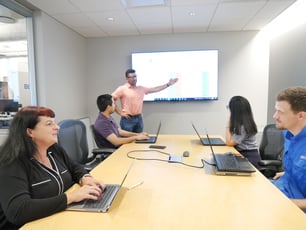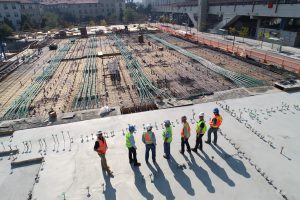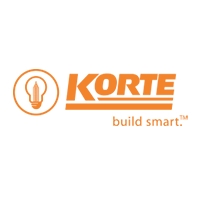Walbridge On Using DESTINI Suite Products
 When Senior Estimator Taimoor Khan went to work at the $1.5 billion construction company Walbridge, he brought a passion for technology and a visionary spirit. So, when the company began evaluating DESTINI Estimator estimating software as a replacement for traditional, spreadsheet-based estimating methods, Khan was a natural choice to lead the charge. He became a “super user,” exploring the software’s capabilities through real-life project applications.
When Senior Estimator Taimoor Khan went to work at the $1.5 billion construction company Walbridge, he brought a passion for technology and a visionary spirit. So, when the company began evaluating DESTINI Estimator estimating software as a replacement for traditional, spreadsheet-based estimating methods, Khan was a natural choice to lead the charge. He became a “super user,” exploring the software’s capabilities through real-life project applications.
He shared his journey with us during the evaluation period, discussing his favorite product features, his relationship with the Beck Technology team, and his ultimate rollout plans.
How did you learn of Beck Technology and the DESTINI product suite?
I was introduced to the DESTINI Profiler platform by my previous employer in 2009, as we used Profiler as a 3D modeling tool for presenting to clients. In 2013, I changed companies and started working as a preconstruction manager. My job was to bring innovation to my employer’s existing methods, which were probably 50 years old. I introduced DESTINI Profiler as a first—and well-received—step for the company.
Later I worked for a company that focused on health care work. DESTINI Profiler allowed me to visualize and break down the data, so I could show clients only the information they needed and the impact of change requests. The visual nature and transparency helped considerably with client collaboration. On the overwhelming majority of our projects using DESTINI Profiler, the budgets were quickly approved because the owners were comfortable.
In 2016, I joined Walbridge, which is a large contractor with about 60 estimators. In a company this size, changing our ways and technology takes time. Currently, I am working as a testing engineer for estimating software. I’m using the DESTINI Estimator software as a pilot tool for my projects and will provide feedback to management for a companywide rollout in 2017.
It’s a big impact and a big investment as well as a big risk if you don’t handle it correctly, so our leadership wants to ensure we pick the right solution. So far, the management team has really loved Estimator because of the power of communication. All estimating software can handle estimating, but the main thing for me is which platform is easy to use and provides the best communication and collaboration options both internally and with clients.
What challenges were you facing that you thought could be handled better?
In the past, I would present numbers to clients who were not construction professionals, and the initial reaction was always, “That estimate seems too high.” Clients often cannot relate to the scope of work attached to a number, so a visual representation and drill-down provide comfort. DESTINI Profiler is a cost-estimating tool but, more importantly, a visual communication tool.
What tools was Walbridge using to handle estimating work, prior to using DESTINI?
Walbridge had bought one DESTINI Profiler license before I arrived. For estimating, the team relied on Excel spreadsheets and whatever format they were most comfortable with.
When working with Excel, you may spend two hours preparing an estimate and four hours making sure it’s adding up correctly. Fixing a spreadsheet is a headache, and you will sometimes find out in a meeting that something is not correct, or a formula is off. And there’s no way to confirm or verify information or the quantities you have taken off. In the end, it’s manual as you need to consult two or three different programs to compile information.
So, I started piloting DESTINI Estimator and found it to be very user-friendly and integrated.
How have you learned to use DESTINI software?
For DESTINI Profiler, which I used first at a previous firm, I participated in formal training, teamed with colleagues, and learned on the job. For the DESTINI Estimator pilot, I’ve learned primarily by simply using the tool. I’ve also enlisted Beck Technology’s support team for questions, mentoring, and consulting. As we look toward a larger, enterprise rollout of a technology solution, we’ll include more formal aspects for training and setup for our team.
What advice do you have on how to begin the conversion from a current solution?
The software must be user-friendly. Our estimators range from five to 40 years of experience, so many have their preferred formats fairly engrained, and some are not as computer-savvy as others. We needed a solution that would support all levels of experience and technology skills.
In estimating, we compile a lot of information quickly to respond to our clients’ needs. We don’t have weeks to spend learning software. We need to use 60 to 70 percent of the features intuitively, with minimal training. It’s like a car: you first need to drive it; using GPS comes later.
You must ensure everybody is on board and comfortable with the transition. The approach and speed will vary based on your actual company size, culture, technology-bent, and other factors. In our case we designated a few super users to test different software on actual projects to derive at an end recommendation on the best fit for our firm.
How has the Beck Technology team provided initial and ongoing support?
Beck Technology customer service and tech support are awesome. I make a call, and they help me within minutes – not hours later or the next day. Almost every month, I call to stay in touch and see what’s in development. I have become good friends with their team and feel like one of their secret agents trying to introduce their products to others.
Walbridge has become a partner with Beck Technology to improve the software even further. I am a creative and improvement-driven person, so I like Beck Technology because they are very innovative and visionary. They keep improving their products based on customers’ feedback.
What are some of your favorite features of the DESTINI platform?
In DESTINI Estimator, I like the organization of the data, creating different assemblies, and comparing different versions of estimates. And the integrated 2D and 3D takeoff feature is amazing. These are the top four features that I have seen missing in other estimating software.
Data filtering lets me sort data in different ways, and it’s much easier compared to other software. With Estimator, I can do it with a couple clicks versus 10 steps. It’s much faster.
The data manager that works in the background is a great tool. It organizes data in such a way that no matter how you set up your estimate, you can convert it into any format at any time. It will still be the same data, but you can look at it in different ways. The format options work for different people, such as architects or owners.
If I’m creating a concrete footing foundation assembly, I input my quantities in one spot, and all associated line items populate. I don’t have to put the information in six different places; that functionality saves considerable time.
I also rely on the estimate comparison tool. Owners like to know what happened since the first estimate version. Why is it more now? Estimator lets me drill down to the detail and quickly see that there’s more carpet, windows, or brick. You can move from schematic drawings to design development drawings and see what the architect has changed that impacts the cost.
What kind of reaction have you gotten from clients and the team at Walbridge?
Estimator is built on the same philosophy as Profiler, so I’m confident our clients will love it. DESTINI enables transparency and communication, two keys for successful projects.

-1.png?width=112&height=112&name=image%20(4)-1.png)














